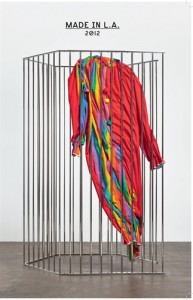Debating the Made In L.A. Catalog
 As Made In L.A., 2012 nears its closing week many of us are coming to terms with the exhibition catalog, a hefty critical document, indeed. My collegue Roman Stollenwerk and I began a debate about its significance. We thought it would be a good idea to open up the debate to more voices. Here is our exchange, comments are open:
As Made In L.A., 2012 nears its closing week many of us are coming to terms with the exhibition catalog, a hefty critical document, indeed. My collegue Roman Stollenwerk and I began a debate about its significance. We thought it would be a good idea to open up the debate to more voices. Here is our exchange, comments are open:
(Full disclosure, while I had no invlolvment in organizing Made In L.A. or its catalog, I do work for the L.A. Municipal Art Gallery, a host venue for the exhibition.)
Roman Stollenwerk: The essays/introduction in the “Made in L.A.” catalogue are really quite good. An example of the craft of skilled criticism and curatorial practice. Whether you like all the work or not, and whether you like the direction that LA art has headed, it is well done. However, the lack of hard edge seems wrong…it is LA afterall.
Gabriel Cifarelli: I thought the opposite. I thought the writing on individual artists was typical of contemporary criticism; it more often communicated the interests of the artists rather than providing an independent perspective, acting as a sort of William Safire role of artist speech writer. The introduction tried to turn the artists into allegories of what it means to be an Angeleno which is a form of myth or archetype criticism, or even Romantic criticism.
Roman: I agree on the individual artists. Andrew [my partner] commented that the wall text seemed odd…and I commented that it was perhaps based on artist statements. But I found the intro approachable but intelligent and it articulated what I see to be true about LA artists. With a show like this, the reduction to stereotypes, essentially, is part of the deal. The whole point of the show is a “what makes LA art LA” so it must approach the discussion from that viewpoint for the first edition. Honestly, Art History and criticism are all about reduction, simplification and myth creation.
Gabriel: I have no problem with the reductive generalizations in the catalog, that is the nature of criticism, I just wish they were based less on assumptions about LA and what “LA” supposedly means, what I think is a lazy sociology, and more about specific claims about art making and art movements. I know we are in a post-movement era, but I don’t think this means we should replace the identification and description of art movements with regionalism.
Roman: But this exhibition is explicitly regional. I would also argue that most movements are regional. I’ll have to think about it, but aren’t most movements closely tied with a city or region? Defining a region at a particular time is very much about identifying movements – unless you hope to identify international movements, which is very problematic. Although, in the current world of international art fairs, I suppose it is possible. Perhaps I welcome the regionalism because it avoids jet set internationalism. But I think I’m veering off topic at this point.
also by Gabriel Cifarelli
- The Painting Factory: Abstraction After Warhol - June 9th, 2012
